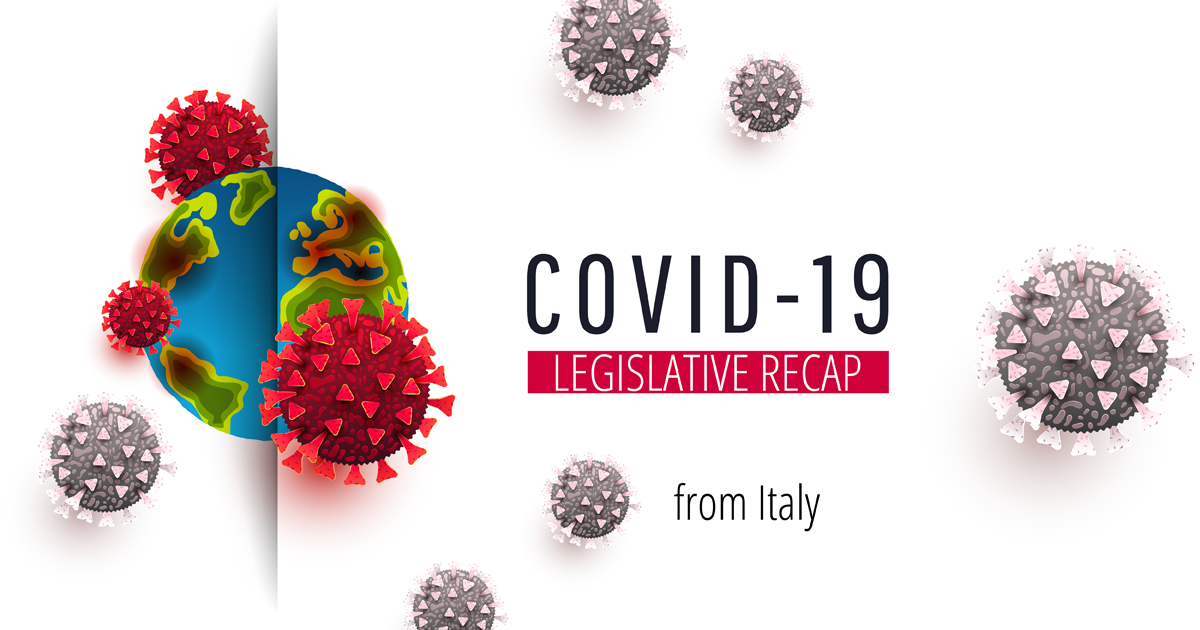COVID-19: Focus on Italy. The fifth legislative recap
An overview of the situation in Italy, with regards to the Covid-19 contagion spread and the Government’s response. You will find:
- A timeline of the major events that marked the contagion spread and the measures taken by the Government
- An overview of how the resumption of economic activity played out (“phase 2”) and the next steps already legislated by the Government
- A major shift in the distribution of powers: the Regions are now in charge of presiding over “phase 2”
- An overview of the €55 billion economic recovery package adopted by the Cabinet on 13 May
- The expected impact of the €55 billion package on public finances as the economy shrinks due to the lockdown: macroeconomic estimates produced by the Treasury in its Multiannual Financial Framework
- The latest available data on the contagion spread (as of 18 May).
TIMELINE
22 January 2020
Ministry of Health Guidelines to healthcare units: patients to be tested for coronavirus include those showing symptoms of severe acute respiratory infection who have also visited China in the 14 days before the symptoms or have been in contact with someone who has.
31 January
All direct incoming flights from China, Hong Kong, Macau and Taiwan suspended. Still no measure in place to test and place in quarantine those arriving from other countries after visiting China.
8 February (until 22 February)
The Ministry of Health runs an ad on national TV channels where a well-known actor says that “the contagion spread is not at all easy”.
18-20 February
“Patient 1” visited in a hospital in Codogno, south of Milan (Lombardy Region). According to the Guidelines of the Ministry of Health, he is not tested because he had not visited China, and he is sent home on 18 February. Symptoms get worse and he shows up again the next day: this time he is tested and diagnosed with coronavirus, after infecting his relatives, several patients in that hospital as well as health professionals. This marks the beginning of the (recorded) circulation of the virus in Italy.
22 February
The Ministry of Health revises its guidelines to healthcare units: those who show symptoms of a severe acute respiratory infection should also be tested.
24 February
Government establishes two “Red Zones” which are completely locked down:
- 10 towns in Lombardy (including Codogno)
- 1 town in Veneto
Business activities are suspended in that area.
1 March
The rules applying to the “Red Zones” are extended until 8 March.
A “Yellow Zone” is established, including 3 Northern Regions (Lombardy, Veneto, Emilia-Romagna) plus 2 other Provinces in other neighbouring Regions.
Restrictions to social interaction were in place throughout the “Yellow Zone” (including the suspension of sports events, organized public gatherings, school and university attendance, limitations on the opening hours of museums, restaurants, bars, shops, malls etc.) but there was no generalised suspension of business activities.
2 March
The Government adopts legislation providing for an extension of deadlines for tax/bill payments for households and businesses in the “Red Zone”.
4 March
A number of restrictions are imposed on the whole country. School and University attendance is suspended until 15 March.
8 March
The lockdown regime is lifted on the 11 towns of the former “Red Zone”. Lombardy + other 14 Northern Provinces now form an “Orange Zone”, where severe limitations to social interaction, freedom of movement and some business activities apply, but no lockdown is in place: manufacturing sites continue to be operational and transport of goods is not affected.
9 March
The “Orange Zone” regime is extended to the whole country, until 3 April.
11 March
The “Orange Zone” regime is tightened: with a few exemptions, retail merchants are shut down until 25 March. Manufacturing sites are still not impacted.
11 March
Upon the Government’s request, Parliament authorised an increase in the 2020 deficit ceiling by €25bn.
14 March
Amid blue collars’ protests, the Government signs a protocol with Unions and business associations to safeguard workers’ health in manufacturing sites, in an attempt at avoiding a shutdown of factories.
17 March
The Government passes, with the Decree-Law 17 March 2020, n. 18, a €25bn package of measures to provide economic relieve to households and businesses.
22 March
The “Orange Zone” is further tightened through a Prime Minister Decree: the lockdown now applies to manufacturing sites as well, although with several exemptions. All previous measures are extended until 3 April.
24 March
Restrictions on the movement of people are also extended until 3 April, including an obligation for anyone entering Italy to undergo a 15-day quarantine (unless they are entering the country for proven work reasons, in which case they can stay in Italy for no longer than 5 days).
25 March
- The list of manufacturing sectors that are exempted from the lockdown is slightly amended through Decree 25 March 2020 signed by the Minister of Economic Development, Patuanelli.
- The Government sets out a new legal framework (Decree-Law of 25 March 2020 n.19) for any future restriction until 31 July. Regions may adopt additional restrictions but are not allowed to take measures that impact on production facilities.
28 March
Amid concerns about the spread of poverty throughout the country, the Government distributes €400 million to local Administrations (Municipalities) so that they can provide low-income citizens with food stamps.
1 April
The “Orange Zone” regime is extended until 13 April.
3 April
Peak of patients in intensive care units (4,068). This figure started declining on 4 April
4 April
Peak of (non-ICU) hospitalised patients showing Covid-19 related symptoms (29,010). This figure started declining on 5 April
6 April
The Government passes a new package of measures to provide liquidity support to businesses (Decree-Law of 8 April 2020 n.23): bank loans to businesses are assisted with the State’s guarantee, with a view to mobilising up to €200 billion.
Moreover, this package includes measures (specifically, art. 15, 16 and 17) extending the scope of the s.c. Golden Power (e.g. special intervention power aimed at protecting strategically-relevant assets from foreign acquisition, by imposing conditions or even vetoing notified transactions).
10 April
The “Orange Zone” regime is extended until 3 May, with minor exemptions.
14 April
First meeting of the working group (chaired by former CEO of Vodafone Vittorio Colao) which will deliver recommendations to the Government on when to lift the restrictions on individual economic sectors.
19 April
Peak of confirmed active cases (108,257). This figure started declining on 20 April, which means that the total number of patients who recover or die over the last 24 hours is higher than the number of new cases.
20 April
The Regional and Mayoral elections scheduled in May-June 2020 were postponed to September-December.
26 April
A PM Decree sets out the rules applying from 4 May to 17 May (“phase 2”): factories and businesses in the construction sector are allowed to reopen, conditional upon compliance with workers’ safety protocols.
30 April
A Decree of the Minister of Health lays down the indicators according to which this risk assessment will be conducted during “phase 2” with a view to detecting any threats and adopt restrictions on a regional or sub-regional basis accordingly.
4 May
“Phase 2” begins, according to the rules set out by the PM Decree of 26 April
13 May
The Cabinet adopts a €55 billion economic recovery package, still unpublished to this day.
16 May
The Cabinet adopts the Decree-Law of 16 May 2020 n.33, providing for the legal framework for the gradual resumption of the movement of people and economic activity until the end of the covid-19 emergency (31 July).
17 May
A PM Decree lifts most restrictions on economic activity and restores free movement of people within their own Region starting from 18 May.
PHASE 2 OF THE RESPONSE TO THE EPIDEMIC: AN OVERVIEW
Pressure from the business community and Regional Administrations was crucial in overcoming the concerns of the scientific experts advising the Government: the resumption of economic activity was faster than originally announced by the PM in late April.
This is how “phase 2” of the response to the covid-19 epidemic played out:
4-17 May:
- Businesses in the manufacturing sector as well as constructions were allowed to resume their activity, on the condition that they complied with a protocol on workers’ safety agreed upon between the Government, Unions and business associations
- All other businesses, including nearly all retail shops, remained locked down unless smart working was a viable option
- Circulation of people within their Region was still subject to restrictions: anyone checked by the Police was still under an obligation to submit a self-declaration stating the reasons for being out of his/her home
- Circulation of people across Regions was still severely limited, and only allowed for proven health/work reasons or in case of urgent needs
- Border crossings, including those from/to Schengen countries, remained restricted. As before, anyone entering Italy from abroad would be placed in quarantine for 14 days, with the exception of those who came to Italy for proven work reason and stayed for maximum 5 days and those who travelled across Italy towards a final destination abroad and stayed for max. 36 hours.
18 May onwards
- With a few exceptions, all businesses are now allowed to resume their activities, including those with a higher contagion risk including retail shops, bars/restaurants, barber shops/hairdressers, on the condition that they comply with sector-specific guidelines as well as with the general workers’ safety protocol
- Circulation of people within the Region where they live is now fre
- Circulation of people across Regions is still limited and subject to self-declaration, as before
- Border crossings remain restricted and subject to self-declaration as described above, but residents in Schengen countries may cross the Italian border and stay without a deadline if they bring evidence that they are visiting Italy for work reasons.
Next steps already legislated by the Government are:
25 May
- Gyms, swimming pools and sports centres will be allowed to reopen, on the condition that they comply with sector-specific guidelines as well as with the general workers’ safety protocol.
3 June
- Circulation of people across Regions will be free. It may be restricted once again, on a case-by-case basis, only in case a new contagion threat emerge
- Circulation of people to and from Schengen countries, plus the UK, will be free
- Circulation of people to and from other countries will remain restricted and subject to self-declaration, at least until 15 June: people crossing the Italian border will need to bring evidence that they are visiting Italy for work/health reasons of for urgent needs.
15 June
- Theatres, cinemas and concert halls will be allowed to reopen on the condition that they ensure compliance with basic distancing rules.
PHASE 2: THE REGIONS ARE NOW IN CHARGE
Regions have obtained that the decision-making power is handed over to them with regards to:
- Presiding over the resumption of economic activities. Sector-specific protocols with safety guidelines that business should comply with when they re-open were adopted by the Conference of the Regions, and replaced the much stricter rules that had been proposed by the national Government.
- Restoring restrictions whenever needed. In case the health risk assessment conducted by the Ministry of Health on a number of indicators (e.g. contagion rate, intensive care units capacity, etc.) shows any serious contagion threat in a Region or in a sub-regional area, it will be up to the relevant Regional President to take the ultimate decision of imposing or lifting restrictions, by simply informing the Minister of Health.
€55 BILLION ECONOMIC RECOVERY PACKAGE to tackle the economic downturn
The package was adopted by the Cabinet on 13 May but has not been published yet. These are the main provisions:
Income support schemes (€25.6 billion overall)
- Lay-off schemes for employees whose businesses have either temporarily closed down or reduced their activity due to the lockdown will be extended up to 14 weeks until August 2020, plus 4 more weeks in September-October 2020
- Self-employed workers or those employed under non-permanent contracts who have experienced a significant drop in their income during the lockdown will be entitled to a direct cash payment of €600 for April and €1,000 for May.
Aid to businesses (€16 billion)
- Small businesses with a turnaround up to €5 million will receive direct aid from the Government, on the condition that their turnaround dropped in April 2020 by at least one third vs. April 2019; the aid will be calculated as a percentage of the recorded turnaround drop
- Businesses with a turnaround between €5 and €50 million, whose turnaround dropped by at least one third in April 2020 vs. April 2019, will benefit from a tax credit if they undergo a capital increase in the form of an issue of shares for cash within the end of 2020
- The Treasury through Cassa Depositi e Prestiti (CDP) will lend temporary support to businesses established in Italy, with a turnaround exceeding €50 million, in various forms (e.g. by underwriting bonds convertible into equity, taking part in capital increases, purchase shares on the secondary market etc.); CDP will preferably support high-tech businesses, or those managing critical infrastructures, or those that are part of strategic supply chains, or those that are relevant in terms of employment levels.
Temporary tax cuts (€4 billion) + other tax-related measures
- Businesses with an annual turnaround up to €250 million will be exempted from 2 instalments of the regional Tax on Productive Activities (IRAP)
- Tax payments and social security contributions will be suspended until 16 September 2020
- Moreover, the increase in VAT rates and excise duties already legislated for 2021 onwards will be suppressed.
Additional funding for the NHS and the civil protection department (€3.25 billion)
- The capacity of intensive care units will be permanently improved, from approximately 5,000 to 8,400 beds. The capacity of semi-intensive units will also be improved, thanks to 4,225 more beds
- Community health services will be strengthened by hiring up to 9,000 more nurses
IMPACT OF THE ECONOMIC RECOVERY PACKAGE ON PUBLIC FINANCES
Additional expenses will result in a record-high public debt as the economy shrinks due to the lockdown. According to the estimates produced by the Treasury in its Multiannual Financial Framework, Italy will record a primary deficit for the first time since 1991 (with the only exception of 2009):

CONTAGION SPREAD LATEST AVAILABLE DATA (18 May)
These are the official data which are updated on a daily basis by the Italian Government:
Tests: ~3 million (almost 2 million people tested)
Overall number of people who were infected with Covid-19: 225,886
Deaths: 32,007
People fully recovered: 127,326
Confirmed cases as of 18 May: 66,553 [peak: 108,257 on 19 April]
Of the confirmed cases:
- Hospitalised patients (showing symptoms): 10,207 [peak: 29,010 on 4 April]
- Under intensive care: 749 [peak: 4,068 on 3 April]
- In quarantine at home: 55,597.






SocialTelos